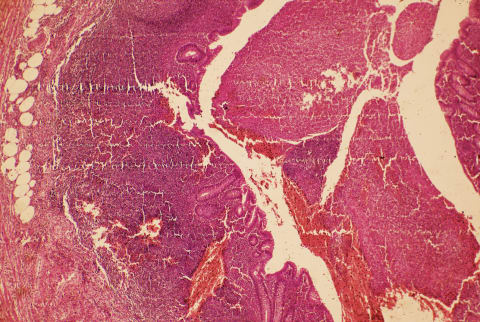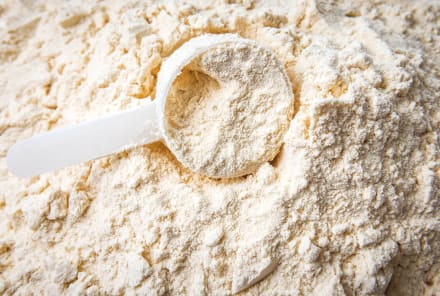Advertisement
Ever Heard Of Digestive Plaque? It Could Be Ruining Your Gut Health


Not a day goes by without a new study being published about the role that our gut plays in our health and wellness. But while we’re starting to appreciate that there’s a whole ecosystem of bacteria and fungi that exists in our guts, there’s one aspect of our digestive health that you’re probably not as familiar with: It’s called digestive plaque.
The common perception is that the germs in our gut are free-floating organisms, just drifting around like stars stuck in some inner-space within us. But that’s actually not correct. What we’ve discovered is that bad bacteria and fungi actually work together to create a thick film along our gut’s lining called digestive plaque. Not only that, but digestive plaque actually acts as a protective shield covering bad bacteria and fungi. Fully protected from probiotic germs, and even medications, the protected bad bacteria and fungi can wreak havoc on our digestive systems.
Digestive plaque can be hard to picture, but it's a major factor in your gut health.
If this is a little hard to picture, I totally get it. The way I like to explain it is this: I love M&M’s. I can’t resist them. So imagine a bowl of M&M’s. They’re just sitting there unprotected from me, the M&M monster; I can scoop them up to my heart’s content. Now instead imagine a Jell-O cake infused with hundreds of M&M’s. In order for me to get to them, I’d have to first break down the Jell-O, and even then, they’d still somewhat be covered by Jell-O ickiness. It’s a lot harder for me to get my hands on them. That’s the best way to think of digestive plaque: If you can’t break down the Jell-O, it’s really hard to get to the M&M’s.
It’s the same paradigm with the bad bacteria and fungi in our guts. If you can’t break down digestive plaque, you can use all the probiotics and medication you want, but it won’t make a difference if they can’t reach the bad germs. The below pictures were taken under electron microscopes at 5,000x magnification. On the left, you can see the dense film of bacteria and fungi, that have literally linked up together to form a thick film. On the right, you can see the remains of digestive plaque that have been broken down.
It’s very much like plaque on our teeth. It’s not the plaque that causes issues with our gums and teeth. It’s the germs that are hidden underneath the plaque that are the real culprits. You can brush all you want, but if you don’t break down oral plaque, germs can keep working away at your teeth and gums.
Bacteria and fungi work together to wreak havoc in your gut.
So you may be asking, "How do you know all this?" Well, I was lucky enough to be the scientist that discovered how bacteria and fungi come together in our guts to form digestive plaque. While we had known for decades that bacteria and fungi keep each other in check, the real breakthrough was my realization that they were literally working together to protect themselves. Microbiologically, it actually makes a lot of sense for bacteria and fungi to cooperate, because digestive plaque allows the germs to become resistant to antimicrobial drugs (like antibiotics) and to be shielded from immune cells. (For example, they can ward off our immune system as it tries to protect our bodies from attack.)
Amazingly, digestive plaque actually allows the protected germs to change, allowing fungi to become more pathogenic and bacteria to develop antibacterial tolerance. Put simply, underneath digestive plaque, bad germs actually become exponentially more powerful and therefore much harder to control.
Here's what you can do to break down digestive plaque.
In my opinion, we have to change our approach to optimizing digestive balance. It’s not good enough to just take a probiotic, because good germs cannot balance out bad germs if you can’t reach them. M&M’s thrown at Jell-O will just bounce off. Instead, we have to first break down digestive plaque, thereby exposing the bad bacteria and fungi underneath. Only then should probiotics be added into the mix, in order to start the process of controlling the exposed bad bacteria and fungi.
When I was developing a probiotic specifically designed to target digestive plaque, we used a two-pronged approach. First, we identified an enzyme that's been shown to have the ability to inhibit the growth of plaques (biofilms). What we found was that when we infused it into our formula, it worked synergistically with our bacterial and fungal strains, which allowed it to break down digestive plaques. Next, we selected probiotic strains that were proven to prevent bad germs from being able to come together and form biofilms. The combination of infusing BIOHM with enzymatic action using strains that are inherently biofilm-resistant, resulted in BIOHM's ability to break down digestive biofilm. (The pictures I shared in the article are actually digestive biofilm by itself on the left, and digestive biofilm after being exposed to BIOHM on the right.)
Yes, you can prevent plaque buildup in the first place.
Diet can definitely help prevent or at least limit biofilm formation. Since we know that fungi are the main culprits in forming biofilms, adopting a diet that is low in carbohydrates (sugars, especially white carbs and refined sugars) and that has a high proportion of amino acids (protein) and fatty acids (especially healthy fats) should certainly help prevent biofilm formation.
So there you have it. Digestive plaque. A scientifically wondrous but devastating phenomenon that’s percolating in our guts. I hope you now have a better idea of just what’s going on with the germs in your gut! But the work is not done. Since my discovery, I’ve continued my research in the hope of answering the question, How do digestive plaques actually work? It’s a question that we’re feverishly working to answer but one that still evades us.
Did you know that a healthy mucus layer is also crucial for great gut health?
Watch Next
Enjoy some of our favorite clips from classes
Enjoy some of our favorite clips from classes
What Is Meditation?
Mindfulness/Spirituality | Light Watkins
Box Breathing
Mindfulness/Spirituality | Gwen Dittmar
What Breathwork Can Address
Mindfulness/Spirituality | Gwen Dittmar
The 8 Limbs of Yoga - What is Asana?
Yoga | Caley Alyssa
Two Standing Postures to Open Up Tight Hips
Yoga | Caley Alyssa
How Plants Can Optimize Athletic Performance
Nutrition | Rich Roll
What to Eat Before a Workout
Nutrition | Rich Roll
How Ayurveda Helps Us Navigate Modern Life
Nutrition | Sahara Rose
Messages About Love & Relationships
Love & Relationships | Esther Perel
Love Languages
Love & Relationships | Esther Perel

















